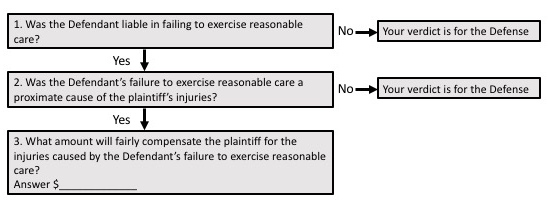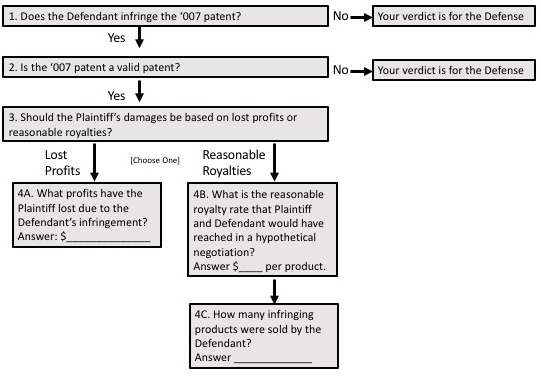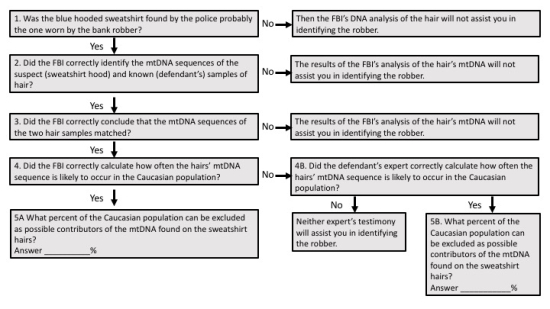By Dr. Ken Broda Bahm:
Wherever juries are used, we tend to expect quite a lot out of them. As Marie Comiskey, Senior Counsel with the Public Prosecution Service of Canada, has written, “While first-year law students are given a semester to learn the rudiments of criminal law, jurors are expected to become conversant with the essential elements of the criminal law over the space of a few hours while listening to a judge’s instructions.” The instructions in civil law, of course, can be every bit the hurdle of their criminal cousins. When the legally trained look at these instructions and consider them “understandable,” or “clear enough,” I think that assessment suffers from what I’ll call an “analytical privilege:” Lawyers who are trained to think systematically in a discrete and logical sequence are likely to understand the underlying decision tree without having it drawn out for them. For the rest of the population — untrained and far less analytical on average — it is a safe bet that the drawing would help.
I have written previously on the advantage of a flow-chart verdict form, citing earlier research (Fang, 2014). Marie Comiskey’s new article (2016) draws from experience and research in Canada, the U.S., Australia and Europe in order to forcefully argue that using decision trees or flow charts in jury verdict forms could substantially aid juror comprehension without threatening the jury’s freedom to deliberate on its own terms. Pointing to several studies showing greater subjective and objective understanding and comfort with decision making, she concludes “there is promising evidence that juror comprehension can be enhanced through decision trees.” While the innovation has not been tried very often in the courts of various countries, decision trees have been frequently used in the field of medicine, where research shows that they aid in patient comprehension of treatment options. Beyond using decision trees in the verdict design, they can also be used for demonstrative purposes to teach jurors about the flow of their upcoming decision. Building on my earlier thoughts and adapting some of Comiskey’s ideas, this post offers a few additional examples.
Comprehension of civil and criminal instructions is a challenge, and judges, litigants, and academics should all be focused on the question of whether we are supplying enough tools to do the job. It is safe to say that we aren’t. “Given the enormous responsibility on jurors’ shoulders and the compressed amount of time in which they must learn the law,” Comiskey notes, “it is surprising that common-law countries have not done more to develop a vast array of decision aid devices to assist jurors in carrying out their civic duty.” A verbal description of the decision-making process may be comprehensible if the right jurors are willing and able to give it enough attention. A decision tree, in contrast, is comprehensible at a glance, and that ease reduces the cognitive load placed on jurors. It leaves the difficult work where it should be: in the evaluation of the evidence. A decision tree increases the chances that the jury will immediately and easily understand the sequence and consequences of their choices at a level far greater than that which is conveyed in traditional skip-based instructions.
For example, consider a decision tree for simple liability:
The same applies to other paths in more complex scenarios, such as those that would be followed in a patent case.
The decision tree approach can also be applied to specific issues within litigation. For example, the Comiskey article references an example that appeared in a Department of Justice focus group report (McClure, 2007) on the use of scientific evidence in trial. In this case, the illustrative flow chart focuses on specific factual disputes surrounding the prosecution’s use of mitochondrial DNA (or “mtDNA”) evidence in a robbery prosecution.
Of course, the ultimate way the decision tree should be used to teach jurors is as the verdict form itself, and courts and litigants ought to be open-minded in considering that approach. Failing that, however, the charts can be used as demonstrative ways to explain choices that are embedded in more common and prosaic versions of the verdict form.
______
Other Posts on Verdict Determinations:
- See the Process and Not Just the Product in Deliberation
- Consider a Flowchart Verdict Form
- Determine Whether Your Jurors Are Driven by Process or by Verdict
- Get the Gist of How Jurors Decide Damage Numbers
______
Comiskey, M. (2016). Tempest in a Teapot–The Role of the Decision Tree in Enhancing Juror Comprehension and Whether It Interferes with the Jury’s Right to Deliberate Freely?. Oñati Socio-Legal Series, 6(2).
Fang, J. J. (2014). 12 Confused Men: Using Flowchart Verdict Sheets To Mitigate Inconsistent Civil Verdicts. Duke Law Journal, 64(2), 287-331.
Semmler, C., & Brewer, N. (2002). Using a flow-chart to improve comprehension of jury instructions. Psychiatry, psychology and law, 9(2), 262-270.
Image credit: 123rf.com, used under license



